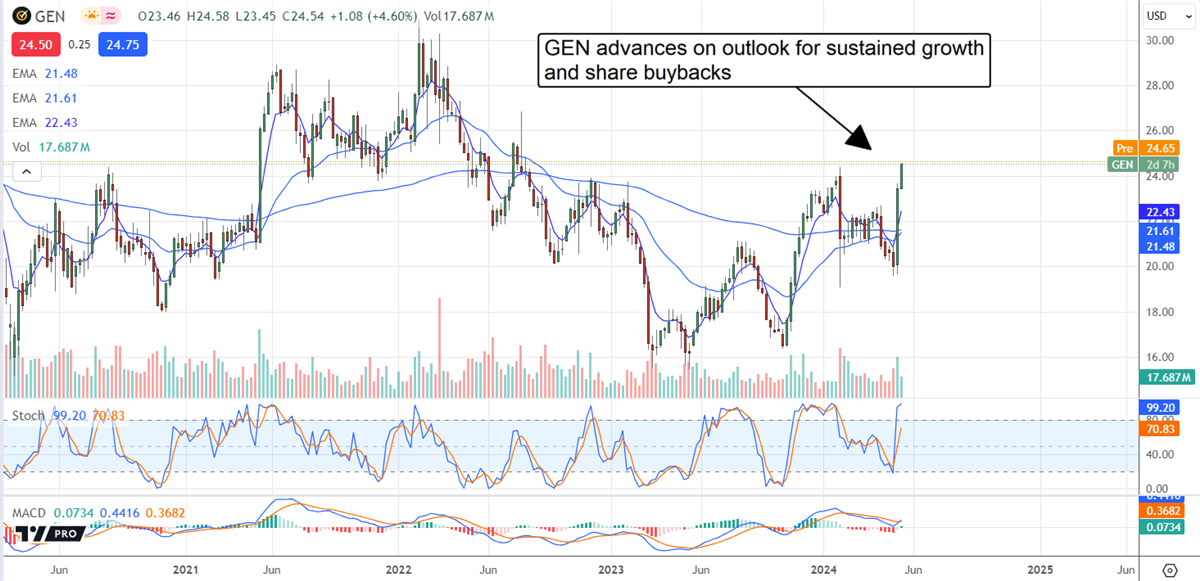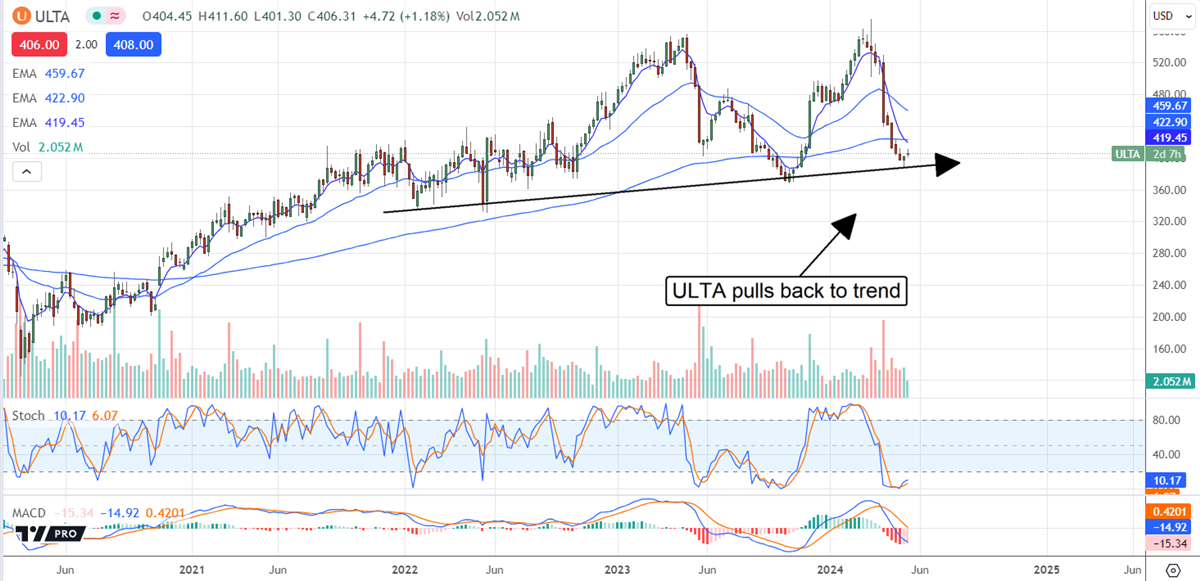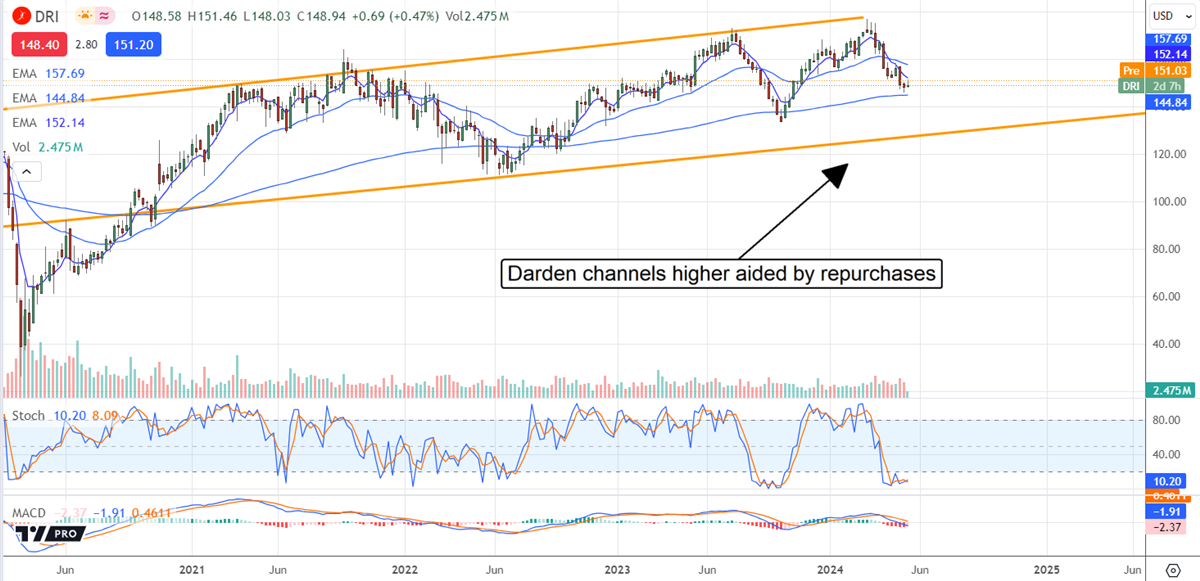
Share repurchases are a controversial topic because they often do little more than hide the impact of share-based compensation or amplify (at face value) sluggish earnings growth. However, as with the stocks today, share repurchases can drive shareholder value by reducing the share count. The long and short of it is that X value divided by fewer shares equals more value per share for shareholders than before. However, share repurchases alone are insufficient to impact share prices positively. Investment success requires a solid business and an outlook for sustainable growth.
Gen Digital Ups the Ante With Share Repurchases; Guides for Sustainable Growth
Gen Digital (NASDAQ: GEN) is a consumer-oriented cyber safety and security firm operating brands that include Norton Lifelock and Avast!. The company is among the latest to issue a new or add-on share repurchase authorization, which is a big one. The company upped the ante by $2.5 billion to bring the total back to $3 billion.
That’s worth 20% of the market cap and more than offsets the impact of share-based compensation. The net result of share-based compensation, dilutive actions, and share repurchases reduced the share count by 1% in FQ4/CQ1 and should continue to do so this year.
A dividend compounds Gen Digital's capital return. The stock pays about 2.0%, with shares trading near a two-year high. The payout is reasonably safe, with a payout ratio of 25% and a healthy balance sheet. The company carries some debt and has a moderately elevated 4X leverage ratio, but no red flags are raised. Highlights from the latest report include increased cash, flat assets, debt and liabilities down, and equity flat.
The recent pop in share prices is due to the results, which were better than expected and point to sustained growth with margin expansion this year and next. Eight analysts rate this stock with a consensus of Moderate Buy and a price target of $26, about 6% above the latest close.

Ulta Beauty has a Beautiful Repurchase Program
Ulta Beauty’s (NASDAQ: ULTA) Q4 results and guidance for Q1 did not inspire the market to rally, but the price pullback is an opportune entry point that aligns with the long-term trend. Share repurchases should help support the market at the critical level where a rebound may already be forming. The company authorized a new $2 billion repurchase plan that went into effect this quarter. The $2 billion replaces the $100 million left under the previous allotment and equals 10.5% of the market cap, with shares near a one-year low. Repurchases are significant for this company and offset the lack of dividends. Repurchases in 2023 reduced the average count by 4.27% in Q4 and should remain strong this year.
Analysts moderated their price targets following the last earnings report, but the sell-off was overblown. Marketbeat tracks seventeen revisions from twenty-one analysts since the report, including an upgrade, a downgrade, and numerous price target reductions. The takeaway is that the range of targets is narrowing, and the consensus fell compared to last quarter but is still well within the one-year range; analysts still view this stock as a Moderate Buy and imply a 35% upside for its price.

Darden Restaurants Has Tasty Returns to Drive Shareholder Value
Darden Restaurants (NYSE: DRI) depressed its market, issuing soft guidance for the year, but is still guiding for growth and margin expansion to support its tasty capital return program. The returns include a high-yielding dividend worth 3.5% with shares near the middle of its uptrending channel. The stock provides a value relative to other high-quality restaurant names, such as Texas Roadhouse (NASDAQ: TXRH), and more than double the yield. Regarding repurchases, this company issued a new $1 billion authorization at the end of FQ3, worth 5% of the market cap. Share repurchases reduced the count by an average of 1.7% for the quarter, and another 1.5% to 2.0% reduction is expected by next year.
Darden’s balance sheet is still recovering from Ruth’s Chris acquisition but is in fine shape. The cash and current assets are down, but total assets are up, long-term debt is well-managed, and equity is flat. The salient point is that the company is well capitalized, has positive and growing cash flow, and has a low leverage ratio below 1X equity. The company can continue increasing its distribution and repurchasing shares.














